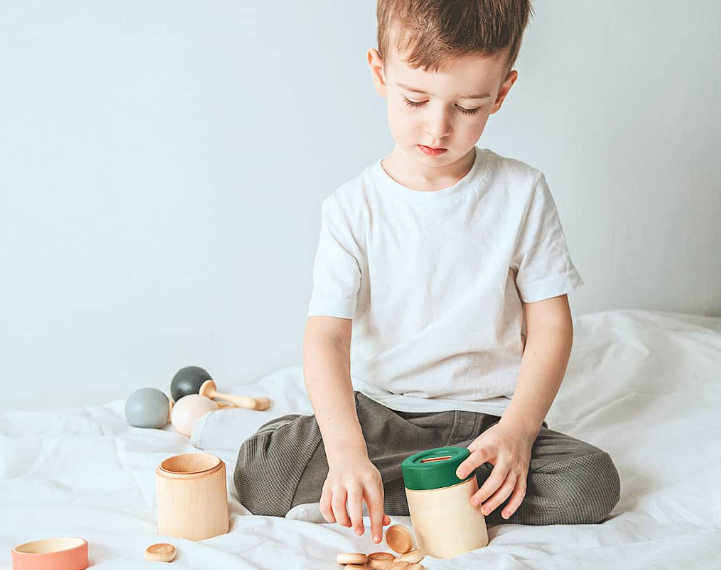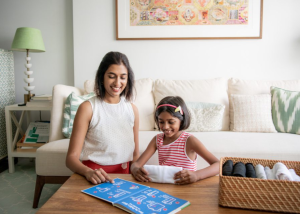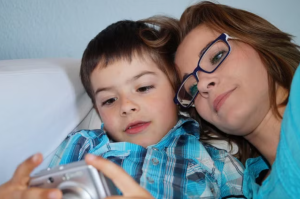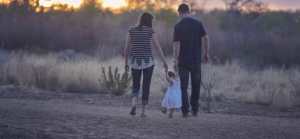Achieving a simple life as a minimalist family involves embracing intentional living. It’s about surrounding yourself with valuable items, eliminating non-essential clutter, and creating more space and time for what truly matters. This journey looks different for everyone, allowing you to retain possessions and make mindful choices about what enters your life. Minimalism isn’t about extreme measures; it’s a personalized approach to simplifying your home and life, offering more room for the things you value most.
These 10 tips are great for getting you started on the path to becoming a minimalist family. By the end, it should feel less overwhelming and more achievable. Becoming a minimalist family not only brings about an immediate lifestyle change but also has a meaningful impact on how you see your possessions, making your life simpler. If you’re ready to begin, you can also use this free 10-page decluttering workbook to assist you in starting the simplification process.
Introduce family minimalism to your kids
Minimalism may seem big for little ones, but they can still understand it! As you simplify your family life, tell your kids what’s happening. Since kids are curious, they’ll likely ask questions when they see you changing things.
Welcome their questions and nurture their curiosity. If they want to join in, allow them! Over time, they’ll likely join in, so if they’re interested in minimalism now, support them.
Since minimalism is a big idea, introduce it gradually. Show it to them in ways they’re familiar with.
Watch shows like Tidying Up with Marie Kondo on Netflix or videos from popular minimalist mom channels with your family. Even little ones can enjoy picture books about cleaning and decluttering. Make it enjoyable and exciting, not just a task.
Talk about why you want to be a minimalist family
Discovering your “why” is crucial for a minimalist family. When things get challenging and life gets busy, your “why” will motivate you to keep going. Consider the reasons you want to embrace family minimalism. Parents may have different reasons than children, and that’s okay.
Gather as a family and discuss what matters most to you. Pose questions to both parents and children about what you want less of and what you want more of in your lives. It could be wanting fewer arguments about chores and more time for activities like hiking or swimming.
You can write down your thoughts by asking questions like:
- What matters the most to me?
- What are my favorite things and activities?
- What’s good about our life and home? How can we improve?
- What do we want more of and less of in our home and life?
- Why do we want to be a minimalist family?
- How can minimalism make our lives happier and better?
- What would you take if you had to leave home with just one backpack or suitcase?
This final question is important to me right now because refugees have arrived in our area (Germany) after losing their homes. It has made me reflect on life and what truly matters. You can learn more about how minimalism can assist in crisis situations here.
Embrace your inner minimalist mom
Children learn from their parents, so it’s important to show them the way!
If you wish for your kids to enjoy a neater and less cluttered life through family minimalism, set an example with your own belongings. Kick off your family minimalism adventure by decluttering your own personal space. I suggest starting with items that hold less importance to you—avoid sentimental items for now. If you’re unsure where to begin, here’s a helpful list of decluttering questions and things you can consider getting rid of.
Start with easy tasks to get comfortable with decluttering. This way, when you guide your kids, you’ll be experienced in handling the emotions that come with letting go of things.
While sorting through your items, have your kids watch or be with you in the same room. This sparks their curiosity. Once you’ve dealt with your more personal belongings, involve your kids. They can assist in organizing, putting things in the bin, or even joining in the decision-making process of what to keep or toss.
Share the responsibility
The whole family should be part of the decluttering process. Yes, even your spouse or partner. They live in the same space as you and should help with decluttering. Encourage them to go through their own things. Everyone should take responsibility for their possessions. This includes your children, who should be involved in deciding whether to keep or let go of each toy, sock, and rubber ducky.
Unlike adults, kids should start with their favorite things when decluttering. This way, they can compare their feelings toward other items. For example, if they have a favorite stuffed animal, they can compare it to other stuffed animals to decide whether or not to keep them. This makes the process of letting go of items easier for kids to understand.
Certainly, kids will need some assistance. Go through the decluttering process with them, offering gentle nudges and reminders about their items. Make the experience positive—getting rid of things should not be seen as a punishment.
Highlight the positives as you go through items. Having fewer things means more time together. Donating unused toys ensures someone else can enjoy them. It also makes it easier for them to find their favorite toys, and nothing will ever get lost!
Set designated clean-up or reset times
Many families that follow minimalism have specific times set aside for cleaning up every day. Being a minimalist is not a one-time task. It starts with a thorough reset of the entire house, but the key is to maintain the newfound order. With established practices and systems, keeping the house tidy becomes easier. Quick and simple cleanups should be sufficient going forward.
Having a daily schedule is helpful for young children. Routine is good for them and makes them more independent. If you allocate a specific time each day for cleaning and tidying up, and it’s consistently at the same time, children will come to expect it. They might even start doing it on their own if they understand the schedule!
The best time of the day for cleaning will vary for each family. You might have a couple of times, like in the morning, to make the bed and tidy dirty clothes, and before bed to clean up toys from the day.
Apart from the kids’ cleanup time, you and your partner should also have your own time for adult cleaning. This includes tasks like cleaning toilets, doing laundry, and other adult-only chores.
Give each item its own spot
If I could share one essential tip for family minimalism with any mom, it would be this: everything in the house needs to have a spot. And I mean absolutely everything. You should be able to point at any item in the house and know exactly where it belongs, as should any other member of your family.
This will help you immensely by cutting down on cleaning and tidying up times. No more wondering where to put things, stuffing them in the wrong place, and making a further mess. Likewise, you’ll be able to find everything instantly. No more dumping out the toy box to find that one item!
This may mean getting kid-friendly shelves, step ladders, boxes, bins, and labels to organize things. Trust me, they’re worth it! Make sure your kids know where all of their items belong. Everything that belongs to them needs to be easily accessible. They need to reach things easier, take them out without making a mess, and put them back where they belong.
At first, you may have to do reminders, but eventually, they’ll get the hang of it. The day they clean up after themselves without being asked will go down in the history books!
Practice mindful shopping
It’s more challenging to get rid of clutter once it’s in your home, so why not stop this habit from the start?
Practicing mindful shopping can help you avoid impulse spending and retail therapy. This not only saves you time and money but also the energy and effort you’d otherwise spend decluttering and finding new places for unwanted items later. Let’s face it – you likely didn’t want or need that thing!
Here are some simple shopping tips:
- Make a list before you go shopping, and stick to it!
- If you want something, wait 24 hours or even up to 30 days before buying it. This helps you figure out if it’s a real need or just an impulse.
- Consider where the new item will “live” in your home.
One in, one out
Here’s a simple rule for family minimalism: the one-in-one-out rule. When you buy something new, it’s time to let go of something old. If you get a new item, like a book or a piece of clothing, consider donating or recycling one you no longer need. This rule applies to your kids’ stuff, too, especially with clothing that they quickly outgrow. Involving your kids in the process by sharing your shopping list can help them stay focused and less likely to ask for unnecessary items when out shopping.
Prioritize experiences over things
One great aspect of family minimalism is that it lets you concentrate on experiences instead of possessions.
When I look back on my childhood, I don’t recall the gifts I received at the age of nine, but I remember the family trip to Disneyland.
I bet you feel the same way – go ahead, try it! For most people, it’s the memories of enjoyable activities that leave a lasting impression, not the things they bought or owned.
Instead of using your money on material possessions, you can invest it in family vacations, day trips, and other memorable experiences.
Gifts and holidays
I get asked about this topic so often that I had to devote an entire section to it!
Have you ever been to a birthday party where a child opens up so many gifts they lose their magic? On the first gift, their eyes sparkle, but by the time they open the last one, they’ve forgotten all about the first one.
This is exactly what we want to avoid. Practicing minimalism at Christmas, birthdays, and other special events is possible!
If possible, try to ask family members and friends to keep gifts to a minimum. They can also gift experiences or ask for items you know they need. This will help prevent the clutter from creeping up, and the overwhelm of too many items from happening.
This doesn’t make the holiday any less magical. Trust me, your kids won’t notice or care about the number of gifts they get! The thought and love will resonate, even at a young age.
Communicate with each other
Finally, embrace the mindset of a minimalist family. Minimalism encourages positive habits that enhance your appreciation for family and the life you’ve created. By reducing unnecessary items, you create more time to spend together. Minimalism strengthens relationships and fosters gratitude for the things you truly value. Every item serves its purpose, and letting go becomes a joyful and thankful experience. Remember, minimalism should always be a positive journey. If it feels like a punishment or brings sorrow, you might need to reassess and choose what aligns best with your family, regardless of external opinions.









